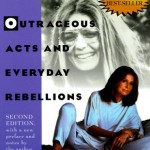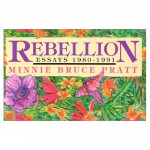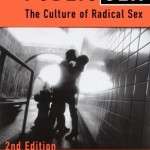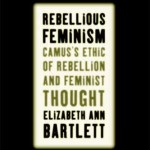I came across this cartoon in a recent New Yorker today:
Here is one reason (among many others) that I love this cartoon: As someone who persistently challenges the status quo and asks a lot (and I mean a lot!) of questions to myself and others, I am sometimes criticized for “taking the fun out of everything.” Uh oh. Here comes that troublemaker again. Why does she have to ask so many questions? Does she ever stop thinking? Can’t she ever just relax and have fun?
In some of her most recent work, (here and this upcoming book here), Sara Ahmed writes about these ideas in relation to (un)happiness and the feminist killjoy. Here is what she says about the feminist killjoy in her essay, “Happiness and Queer Politics“:
Say, we are seated at the dinner table. Around this table, the family gathers, having polite conversations, where only certain things can be brought up. Someone says something you find problematic. You respond carefully, perhaps. You might be speaking quietly, but you are beginning to feel “wound up,”recognizing with frustration that you are being wound up by someone who is winding you up. Let us take seriously the figure of the feminist killjoy. Does the feminist kill other people’s joy by pointing out moments of sexism? Or does she expose the bad feelings that get hidden, displaced or negated under public signs of joy?
In her larger argument, Ahmed is interested in how happiness–read here as good feelings of contentment and pleasure–gets directed toward specific futures (like marriage and the wedding day as the happiest day of your life). For her, happiness comes at a cost. It is tenuous, restrictive and it conceals the unhappiness that it produces. The feminist killjoy kills others’ joy (takes the fun out of everything) for a reason: to remind them that unhappiness is a necessary result of certain imposed visions of happiness. Ahmed suggests that feminist killjoys (and also queers who resist hetero-happiness) are important because they stay not happy (they stay in trouble, perhaps?) by refusing to be happy on the terms that are dictated by a straight world.
Ahmed sees happiness as dangerous:
- “The risk of promoting happy queers is that the unhappiness of the world could disappear from view” (9).
- “The good faith in queer progression [towards happiness, acceptance, contentment] can be a form of bad faith. Those of us committed to queer life know that forms of recognition are either precariously conditional–you have to be the right kind of queer by depositing your hope for happiness in the right places–or it is simply not given” (9).
- “…it conceals the ongoing realities of discrimination, non-recognition and violence, and requires that we approximate the straight signs of civility” (9).
She concludes that: “We must stay unhappy with this world” (9). This unhappiness does not mean being sad or miserable. Ahmed believes that resisting happiness (in the form of unhappiness) “opens up other ways of being” that are not constrained by preconceived visions of happiness and the good life. These other ways of being could allow for an increase in possibilities of what could/does/should happen. In this way, queers–and feminist killjoys too?–could put the hap (as in what happens and of being perhaps) back into happiness (16).
In this essay, which I am still working through, Ahmed only briefly mentions the feminist killjoy. How is she linking this figure with the unhappy queer? I can’t wait to read her upcoming essay in Signs about the feminist killjoy (Spring 2010). In my class on feminist and queer explorations in troublemaking I am really interested in how making trouble functions in different feminist and queer contexts. It will be helpful to see how/where Ahmed places feminism within her own queer project.
I really like what Ahmed is doing in this essay. I see many connections between unhappiness/the feminist killjoy and troublemaking. Ahmed does too; at one point in the essay, she describes unhappiness as “causing misfortune or trouble” (10) and then links it with being miserable and wretched. While it would be easy to read the connection between unhappiness, trouble and wretchedness as an argument for the impossibility of happiness (and the fundamental disconnection between happiness and trouble), this is not what Ahmed is doing. She wants to rethink what happiness could be (to put the hap back in happiness), by “rewriting it from the point of the view of the wretch” and by exploring how to “estrange us from the happiness of the familiar” (11). Happiness becomes less about contentment or following the right path (towards hetero-happiness and the good life), and more about opening up new and uncertain possibilities (more happenings, the perhaps?). This happiness relies on making trouble (unsettling, refusing visions of happiness that constrain) for others’ happiness.
I want to return to my own experiences as a feminist killjoy and as someone who has been charged with “taking the fun out of everything.” What sort of fun is being taken away when I ask lots of questions? And who said making trouble by asking lots of questions wasn’t fun? In my own experiences being labeled/dismissed as a feminist killjoy (although admittedly I don’t think I have ever been called a killjoy, maybe a buzzkill or a debbie downer), the assumption is this: having fun means not worrying which means not thinking. For many, the fear is that thinking leads to worrying (which is another word for trouble, right?) which is never any fun. But is their direct link between worrying and thinking/troubling? This past summer I wrote an entry about trouble, worry, and not thinking and how it is linked in a Travelers Insurance Commercial:
Trouble, represented as worry, is something bad that we don’t want and that we suffer through. In this commercial, the uncertainty of the world and our inevitable exposure to others–and the danger that that exposure leads to–are implicitly linked to financial insecurity and the current economic crisis. The solution is not to learn how to deal with our vulnerability (and the inevitability of uncertainty and lack of control which is part of being human) or to develop skills/strategies for staying in trouble in productive ways. Instead, the solution is to buy more insurance, thereby shoring up the illusion that we can have complete and total control over what happens to us. This enables us to stop worrying (and stop thinking) about those things we care about and start enjoying life (because, of course, thinking and enjoying are diametrically opposed). The message in this commercial is: You want to stop being troubled by your tenuous financial situation? Don’t worry. Stop losing sleep over it. Buy more insurance and then you don’t have to think about it anymore. Or, put more simply: Don’t think. It makes you worry too much. Leave the thinking to someone else, like Travelers Insurance.
But what sort of joy and enjoyment is possible when we think and when we make others think? Is it possible to imagine the dinner table differently, where asking questions leads to intense conversations or radical shifts in world views? Could it be a place of joy, imagined as something like Audre Lorde’s notion of erotic as feeling (as opposed to the traditional definition of joy/pleasure/happiness as contentment, comfort or safety)? Now, my discussion of the feminist killjoy and happiness is a departure (I think) from Ahmed and her interest in happiness. I will write a follow-up post in 2010 once I have read her specific analysis of the killjoy within feminism. I can’t wait.
As a conclusion, I just want to add: Does anyone else immediately think of Kilroy when they hear killjoy? I can’t seem to get “Mr. Roboto” by Styx out of my head. In case you weren’t thinking about that, here it is. You’re welcome.





